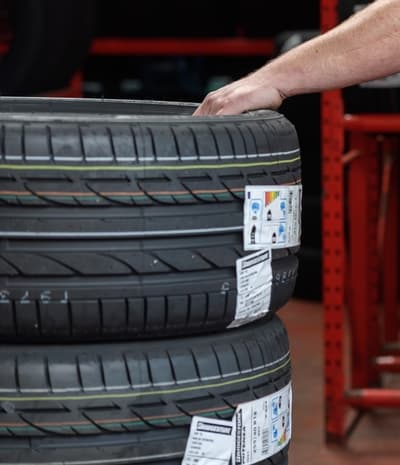Tyre types – what are the differences
Tyres are one of the most important safety features on your vehicle. They are the only part of your vehicle that makes contact with the road and they need to be in tip-top condition to cope with all weather conditions, including the very changeable weather in the UK.
Tyres need to carry your vehicle’s weight and load, they maintain directional control and steering and act as shock absorbers on different road surfaces.
Tyres have certainly come a long way and tyre manufacturers continue to invest in new technologies and are creating innovative designs to improve performance, safety and efficiency, with a focus on environmental impact.
We hope the following information will help you better understand tyres and answer some frequently asked questions.

Summer or performance tyres
Summer tyres are the most commonly fitted tyres on new vehicles in the UK and offer excellent safety, comfort and performance in warmer temperatures.
Summer compounds are relatively hard and can soften during milder temperatures to cope with dry and wet road conditions. They have fewer sipes and unique tread patterns which help to minimise aquaplaning. When temperatures drop below freezing the summer tyre compound and treads become less effective and you might want to consider changing to all-season or winter tyres.
If you decide to change to all-season or winter tyres, you will need to change all four tyres, as the tread patterns and depths are different. Mixing tyre types can be dangerous and will make your car unstable and difficult to control.
All-season or all-weather tyres
All-season tyres, sometimes called all-weather tyres are designed to cope with all weather conditions, combining summer and winter technologies into one tyre. All-season tyre tread depths are thicker than summer tyres and thinner than winter tyres, they have different compounds and tread patterns that offer a quieter and comfortable ride, they also tend to last longer.
All-season tyres are a good choice for people who don’t want to switch between summer and winter tyres, especially when it comes to storage space for a full set of tyres. If you decide to change your tyres to all-season, you will need to change all four tyres, as the tread patterns and depths are different. Mixing tyre types can be dangerous and will make your car unstable and difficult to control.
Wet weather tyres
Sometimes people ask about wet weather tyres, these are very similar to summer tyres. Wet weather tyres have a harder compound than an all-season tyre and a slightly softer compound than performance summer tyres.
Wet weather tyres have more sipes to help dispel water from the tyre’s contact patch with the road and are often used in motorsport, especially when the race track is very wet.
Winter tyres or cold weather tyres
People often think winter tyres are only suitable for snow and ice, which is not the case. Winter tyres are designed to improve grip and braking in cold, wet, icy and snowy weather. These tyres are especially good for rear wheel drive vehicles.
Winter tyres have different compounds and tread patterns, they have a more natural rubber which stops it’s hardening during colder temperatures, resulting in better grip and flexibility. They also have more grooves and sipes than standard/summer tyres, which improves braking and acceleration on snowy and icy roads.
Winter tyres best perform when temperatures drop to 7 degrees celcius or below, which is quite frequent in the UK, making them more and more popular each year.
All-terrain or 4x4 tyres
All-terrain or 4x4 tyres have excellent traction across all different surfaces on-road and off-road. They have open tread designs and larger blocks similar to off-road tyres enabling them to grip rough terrain like mud, sand and gravel. They also have reinforced sidewalls and harder tyre compounds to prevent damage from off-road hazards, like rocks and uneven ground. The harder compound can make the tyres last longer, but tend to be noisier. The larger tyre blocks on all-terrain and 4x4 tyres can reduce contact with the road, so you must be careful when driving at speed.
They come in a variety of difference tread patterns, with some more suited to off-road, so make sure to choose the right tyre to suit your driving habits.
Mud tyres
Mud tyres are similar to all-terrain tyres, but are designed for off-road. They have massive tread blocks, which can cut through rough terrain, including rocks, mud and sand, and are less likely to puncture.
Most mud tyres don’t perform well on wet roads, as they are not able to dispel water due to the extra-large tread blocks, which can increase your risk of aquaplaning.
Here at National we stock a number of different tyre types to suit a range of needs. If in doubt about what tyres to chose, simply enter your vehicle registration into our tyre search box or call one of our knowledgeable and friendly tyre experts at your local branch on 0800 62 66 66.
Did you enjoy this blog post? |2 people found this review helpful



 Sign up for SPECIAL OFFERS
Sign up for SPECIAL OFFERS
